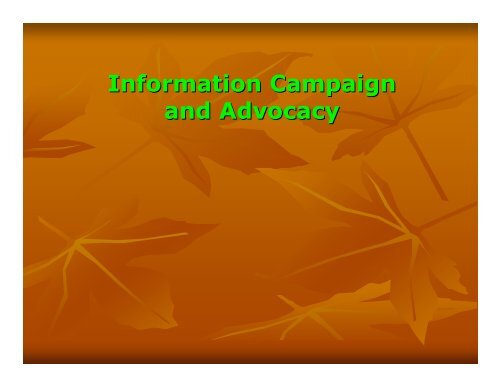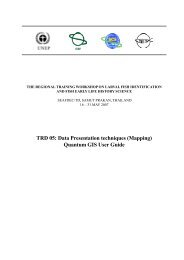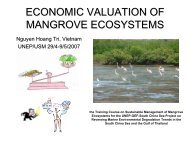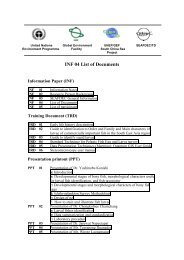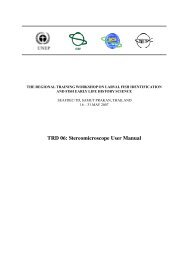Information Campaigns and Advocacy
Information Campaigns and Advocacy
Information Campaigns and Advocacy
Create successful ePaper yourself
Turn your PDF publications into a flip-book with our unique Google optimized e-Paper software.
<strong>Information</strong> Campaign<br />
<strong>and</strong> <strong>Advocacy</strong>
Remember that…<br />
Implementing a development project is a<br />
social process, not a sequence of<br />
administrative or technical decisions.<br />
As such, IEC is an important tool<br />
in this process.
Basic IEC functions<br />
To inform ><br />
To educate ><br />
To motivate ><br />
To persuade ><br />
To entertain ><br />
Action<br />
Ultimate IEC goal: Changing behavior<br />
“Making people do, act, behave the<br />
way you want them to”<br />
“Move people from their present way<br />
to a desired new way”
We learned that…<br />
<br />
<br />
People need to be given information,<br />
but also the motivation <strong>and</strong> skills to<br />
do the desired behavioral<br />
change.<br />
IEC must enable people not only to<br />
know, , but also to want, , <strong>and</strong> do the<br />
desired change.
Stages of Behavior Change Model<br />
I/We know…/Awareness Stage<br />
(Is aware about desired behavior…)<br />
I/We should…/Knowledge/Intention Stage<br />
(Thinking about doing the desired behavior)<br />
I/We want to…/Action Stage<br />
(Trying out the desired behavior)<br />
I/We can!…/Maintenance Stage<br />
(Performs the behavior regularly, as a<br />
natural part of daily life)<br />
Don’t know<br />
(unaware of CRM-friendly behavior)<br />
OR<br />
Don’t Want to Know<br />
(Presently performing behavior harmful<br />
to the environment/resources)<br />
Relapse<br />
(have gone back to the old<br />
ways)<br />
If I /We can, You can!/<strong>Advocacy</strong> Stage<br />
(Encouraging others to perform the behavior)
I know…<br />
I should…<br />
I want to…<br />
I can!
IEC Challenge…<br />
Said is not yet heard,<br />
Heard is not yet understood,<br />
Understood is not yet approved,<br />
Approved is not yet applied…
SMCR Model <strong>and</strong> influential factors<br />
Sender<br />
Berlo’s Model of Communication<br />
Message<br />
Channel<br />
Receiver<br />
Comm skills<br />
Content<br />
Sensory<br />
Comm skills<br />
Attitudes<br />
Treatment<br />
Institutionalized<br />
Attitudes<br />
Knowledge<br />
Knowledge<br />
Social system<br />
Social system<br />
Culture<br />
Culture<br />
FEEDBACK
IEC leads to…<br />
Acquisition of knowledge<br />
Development of analytical<br />
skills<br />
The beginning of<br />
environmentally conscious<br />
attitudes<br />
Environmentally<br />
responsible behavior<br />
Positive change in<br />
KSA
Two categories of knowledge<br />
Knowledge for Underst<strong>and</strong>ing<br />
Knowledge for Action<br />
Knowledge for action is effective<br />
only if it is based on Knowledge for<br />
underst<strong>and</strong>ing<br />
“<strong>Information</strong> <strong>and</strong> knowledge<br />
must be turned into action<br />
if they are to be powerful!”
Guidelines for effective<br />
message development<br />
<br />
<br />
<br />
<br />
<br />
<br />
Keep the message short <strong>and</strong> simple.<br />
Be as completely accurate.<br />
Should be relevant to target audiences – relevant in content<br />
as well as character <strong>and</strong> tone.<br />
Present the message in such a way that viewers, readers or<br />
listeners can act on the information<br />
Give the audience specific behaviors they can perform<br />
If appropriate, demonstrate the recommended behavior <strong>and</strong><br />
teach the skills required to perform it
Best results can be achieved when the<br />
benefits of performing the desired<br />
behavior are communicated<br />
The personality or organization carrying<br />
the message should be credible to the<br />
target audiences<br />
A testimonial, a demonstration of a slice of life<br />
appear to be more effective<br />
A straightforward presentation of facts is often a more<br />
effective appeal<br />
Use a slogan or theme<br />
Be sure that the message presenter is seen as a credible<br />
source of information, whether as an authority figure, target<br />
audience member or celebrity
Effective messages<br />
All persuasion begins with capturing<br />
attention. Without attention, persuasion<br />
is impossible.<br />
– vivid<br />
– concrete<br />
– personalized<br />
Before you craft the content of your message, you need to know<br />
the attitudes, beliefs <strong>and</strong> behaviors of your intended audience.<br />
Use a credible source—the more credible, the more influence<br />
Messages which emphasize losses which occur as a result of<br />
inaction are consistently more persuasive than messages that<br />
emphasize savings.
Effective messages<br />
Make your message specific,<br />
accurate, clear <strong>and</strong> concise<br />
Make it easy for people to<br />
remember how, when <strong>and</strong><br />
what to do<br />
Focus on one or two main<br />
points<br />
Pick one or two main learning<br />
points
Knowledge does not<br />
necessarily lead to action!<br />
Talking about it helps, but<br />
does not make it happen.<br />
Action/behavior does.
What is <strong>Advocacy</strong>?<br />
<strong>Advocacy</strong> is working with other people <strong>and</strong> organizations to<br />
make a difference.<br />
Putting a problem on the agenda, providing a<br />
solution to that problem <strong>and</strong> building support for<br />
acting on both the problem <strong>and</strong> solution.<br />
<br />
Directing action at changing policies, positions<br />
or programs<br />
<br />
Pleading for, defending or recommending<br />
an idea before other people<br />
Speaking up, drawing attention to an<br />
important issue<br />
<strong>Advocacy</strong> must focus on audiences who can<br />
have an impact on the decision-making process
Four strategic elements of advocacy<br />
Art of advocacy rests on 4 strategic elements<br />
.<br />
Communication<br />
Effective argument<br />
Public mobilization<br />
Coalition-building/<br />
constituency-building
Who do we advocate to?<br />
Decision-makers with authority to<br />
affect the outcomes<br />
Individuals who must actively<br />
approve policy change<br />
Individuals <strong>and</strong> groups who<br />
can influence opinion <strong>and</strong><br />
action of decision-makers<br />
<strong>Advocacy</strong> must focus on audiences who can<br />
have an impact on the decision-making process
Various IEC approaches/strategies<br />
Popular<br />
Culture<br />
Social Marketing<br />
(national media<br />
campaigns; agenda<br />
setting)<br />
Development<br />
Support<br />
Communication<br />
(project promotion<br />
<strong>and</strong> support)<br />
Institutionalization<br />
<strong>and</strong> <strong>Advocacy</strong><br />
(mainstreaming;<br />
structural<br />
conduciveness)<br />
Traditional<br />
Culture<br />
Social Mobilization<br />
(participatory,<br />
community media)
Categories of IEC activities/actions<br />
1. Political<br />
2. <strong>Information</strong>al<br />
3. Promotional<br />
4. Organizational<br />
5. Educational <strong>and</strong> interpretive
Some considerations regarding IEC<br />
strategies/approaches<br />
<br />
<br />
<br />
<br />
<br />
<br />
<br />
The most important sources of information<br />
<strong>and</strong> persuasion remain interpersonal.<br />
Very rarely does a person make a decision alone.<br />
Key influentials/opinion leaders must be<br />
identified <strong>and</strong> encouraged to support/champion the cause<br />
Social marketing, particularly mass media is is most effective in promoting<br />
large scale awareness<br />
Mass media helps to create an agenda for public debate. To be effective<br />
however, mass media must be supported by interpersonal <strong>and</strong> group<br />
communication.<br />
Personal testimonies of people are far more compelling than any other form<br />
of communication.<br />
Modeling is often the best way to teach complex behaviors.<br />
Use local information as much as possible.
Support of community/opinion leaders can lead to stronger results.<br />
Actively involve the target audience in the design, implementation<br />
<strong>and</strong> monitoring of project activities.<br />
Establish linkages <strong>and</strong> relationships with, <strong>and</strong> actively involve local<br />
institutions <strong>and</strong> support groups.<br />
Take advantage of local fiestas <strong>and</strong> festivals to disseminate<br />
messages or for inaugural events.<br />
Logos <strong>and</strong> symbols offer a way to create unity.<br />
IEC materials are best distributed when<br />
accompanied by or combined with a<br />
relevant event or activity.<br />
Use appropriate language in IEC<br />
materials to suit the target<br />
audiences.
Some considerations… (cont’d.)<br />
Use maps/spatial/visual aids<br />
Use “prompts” to promote behaviors<br />
Use commitment strategies (pledges,<br />
manifestos, etc.)<br />
Use multiple channels, peer counseling,<br />
learning. Strengthen PO/barangay meetings<br />
as a means for presenting/discussing issues.<br />
Provide recognition <strong>and</strong> rewards. Celebrate!
Where do we begin?<br />
Conduct “Policy Audience Mapping” – a tool to identify <strong>and</strong><br />
learn about key players in the decision-making process<br />
Develop an advocacy theme/goal <strong>and</strong> corresponding specific<br />
advocacy objectives<br />
Identify all parties that have an interest<br />
in the issue (stakeholders)<br />
<br />
<br />
Identify/recruit credible <strong>and</strong><br />
competent spokespersons<br />
Formulate key <strong>and</strong><br />
consistent common<br />
messages
Where do we begin?<br />
<br />
<br />
<br />
<br />
<br />
<br />
Establish roles for the member<br />
organizations<br />
Establish policies regarding dealing<br />
with the media<br />
Conduct formative research –<br />
focus groups to identify stakeholder perceptions <strong>and</strong>/ or the<br />
“public pulse”<br />
Open communication channels when faced with a crisis.<br />
Communicate consistent <strong>and</strong> credible messages.<br />
Establish mechanisms for direct public/audience<br />
communication
What IEC is up against….<br />
<br />
<br />
<br />
<br />
Low public awareness <strong>and</strong> collective<br />
consciousness on resource management<br />
issues/problems<br />
Traditional mindsets about open access<br />
fishing<br />
“Right to earn a living” vs. environmental<br />
considerations<br />
Urgency of the problem.. A race against<br />
time <strong>and</strong> a race that must be won!
IEC in CFRM: From the <strong>Information</strong>al to<br />
the Behavioral Model<br />
They don’t<br />
do<br />
<strong>Information</strong> Model<br />
Why?<br />
They don’t Therefore We inform So that<br />
know<br />
They do<br />
They<br />
Don’t<br />
Do<br />
Behavioral Model<br />
So We must<br />
Underst<strong>and</strong><br />
Why; using<br />
Research to<br />
determine:<br />
Then We must Provide<br />
a Program that<br />
features:<br />
• Services/ features<br />
people want<br />
So that<br />
• Benefits<br />
• Easy access to<br />
• Barriers<br />
what they need<br />
• Perceptions<br />
• <strong>Information</strong> they<br />
• Persuasion<br />
underst<strong>and</strong><br />
• From channels they<br />
trust<br />
They Do<br />
(i.e. allocate<br />
annual budget,<br />
establish <strong>and</strong><br />
protect MPAs,<br />
implement effort<br />
restriction,<br />
strengthen<br />
coastal law<br />
enforcement
IEC planning<br />
Questions to ask:<br />
1. What problem will IEC help address?<br />
2. What are the proposed solutions to this problem?<br />
3. What are the desired behaviors/best practices that will help achieve<br />
desired solution/s or project goals?<br />
2. Which behaviors will be promoted to which audiences?<br />
3. Can these behaviors be influenced by changes in knowledge, attitudes,<br />
beliefs or social norms?<br />
4. What are the motivational/deterrent factors to desired behavior/<br />
best<br />
practices?<br />
5. What organizations will be the focus of the IEC activities?<br />
6. What are the specific IEC objectives?<br />
7. What are the IEC strategies/activities <strong>and</strong> who will implement?<br />
8. What are the messages to be conveyed?<br />
9. What are indicators of success?<br />
10. How will these be monitored?
IEC: An Iterative Process<br />
Major Steps in IEC Planning<br />
1. Identification of the Organization that will implement IEC<br />
2. Identification of the Problem that needs IEC<br />
3. Identification of Target Audiences (Key Players)<br />
4. Identification of Key Messages<br />
5. Identification of Strategic IEC Activities/Channels<br />
6. Identification of Partners/Resources<br />
7. Monitoring <strong>and</strong><br />
8. Evaluation
End of Part 1


